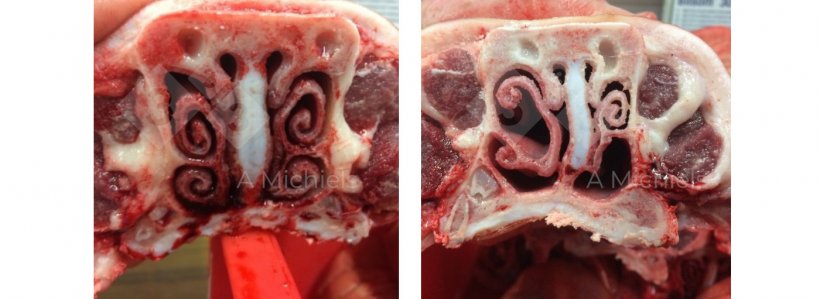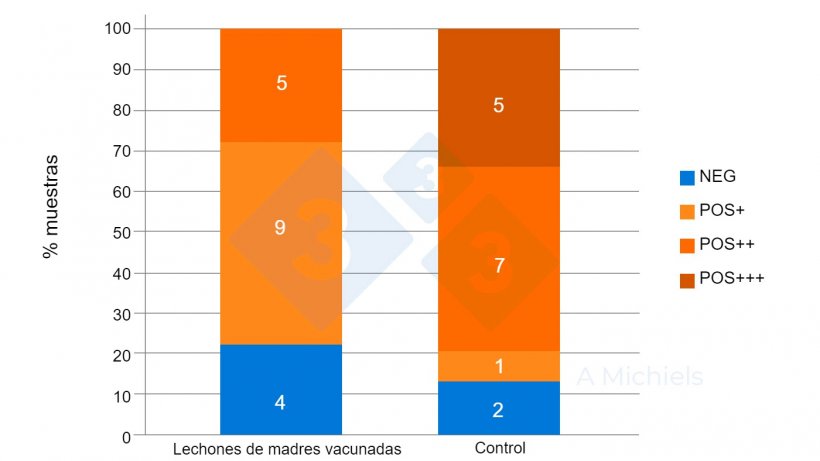The role of non-progressive atrophic rhinitis in pigs – Articles

Everyone knows atrophic rhinitis (AR) as a disease characterized by deformation of the snout. Hence the commonly used name: “twisted face disease.” This deformity is the result of irreversible shrinkage (atrophy) of the turbinates caused by toxins produced by two microbes: Pasteurella multicida type D and Bordetella bronchiseptica.
B. bronchisepticsbacteria
Bordetella bronchiseptica This is a bacterium that is widespread on our pig farms. Its toxicity is due to inflammation of the mucous membrane of the nose and lungs, but it often also causes mild lesions in the form of temporary atrophy of the turbinates. This often means that Infection with B. bronchiseptica is ignored because the lesions are transient and reversible. An experimental challenge study of 4-day-old piglets using CT scanning of the snout showed that the most severe atrophy of the turbinates occurs at approximately six weeks of age, after which the turbinates return to their normal original structure and there is no damage. observed at the slaughterhouse. Because the diagnosis of atrophic rhinitis is often made by cutting the muzzle after slaughter, the non-progressive form of atrophic rhinitis may go undetected.

Influence Bordetella bronchiseptica, but this goes beyond macroscopic lesions. Also affected are the cilia in the trachea, which are responsible for removing foreign substances and microbes from the body towards the throat so that they do not reach the deeper respiratory tract. Thus, infection with B. bronchiseptica makes animals more susceptible to other pathogens.
The most famous example is infection Pasteurella multitocida type D, a bacterium that does not itself have the ability to colonize the respiratory system, but previous colonization B. bronchiseptic facilitates subsequent colonization Pasteurella multicida type D.

Bordetella bronchiseptica as a predisposing factor: in addition to coinfection with Pasteurella
B. bronchiseptics It will act as an opportunistic pathogen by contributing to the porcine respiratory complex (PRC). Due to its pathogenesis, it temporarily atrophies the nasal turbinates and during the transition period affects the respiratory cilia of piglets, facilitating the penetration of pathogens such as:
- Glaesserella parasuis (cause of Glässer’s disease)
- Streptococcus suis
- PRRS virus
- Influenza virus
Thus, protection against B. bronchiseptica can reduce the risk of various respiratory infections and also help animals better fight them.
B. bronchiseptic and its impact on Streptococcus
It’s not just the microorganisms that cause primary respiratory problems that benefit from a cleared path B. bronchiseptic. Also Streptococcus suis (S. Suis) has complete freedom of action when B. bronchiseptic did its job by destroying the nasal turbinates – the first barrier to penetration into the respiratory system.
In an effort to reduce the use of antibiotics, legislation and companies have taken various measures to limit their use. Unfortunately, this also means that one of the tools you can use to prevent problems arising from Streptococcus on the farm. Therefore, in addition to improving piglet quality at weaning, biosecurity and management, we must look at alternative methods of preventing infection Streptococcus. Vaccination against B. bronchiseptic helps reduce mortality associated with S. Suis due to the reduced probability S. Suis to gain access to the piglet.
Practical case
On a commercial farm in Europe, where mortality from meningitis and arthritis is high, he was isolated several times. S. Suis meninges and joints. To monitor the clinic, amoxicillin was constantly added to the water on the farm. The oral fluid contains B. bronchisepticbut no toxin was found P. multicida. Considering that previous literature indicates control of secondary infections through control B. bronchisepticit was decided to investigate The effect of vaccination against non-progressive atrophic rhinitis on the prevention of infection S. Suis. To do this, they were monitored in parallel over time:
- three batches from sows vaccinated with vaccine against non-progressive atrophic rhinitis
- three batches of unvaccinated sows (control group)
Routine use of amoxicillin in water was discontinued during the study.
Results
A clear decrease was observed in the presence B. bronchiseptic in the oral fluid of piglets aged 5 and 8 weeks in piglets from vaccinated sows (Fig. 2).

This decrease is in the presence B. bronchiseptics in oral fluid may be correlated with a 79% reduction in mortality from meningitis in piglets in the vaccinated group. In addition, the total number of antibiotic treatments per 100 piglets was lower in the vaccinated group compared to the unvaccinated group.
Table 1. Piglets from vaccinated sows compared to piglets from unvaccinated sows. Options with
in one column were significantly different.
This farm has reduced the mortality rate associated with S. Suis by vaccination against non-progressive atrophic rhinitis. Therefore, it is important to evaluate whether B. bronchiseptics
is present on the farm, since lesions caused by this microorganism often go unnoticed.
